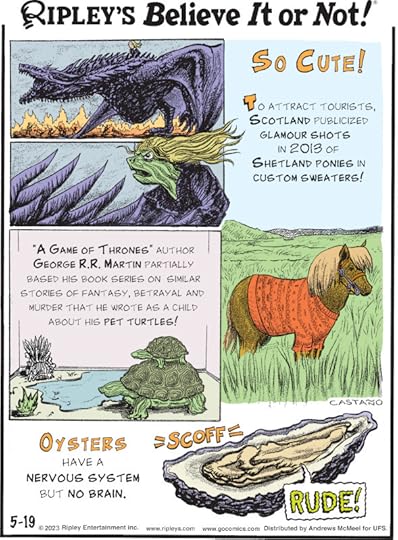Ripley Entertainment Inc.'s Blog, page 26
May 22, 2023
CARTOON 05-22-2023
May 21, 2023
CARTOON 05-21-2023
May 20, 2023
CARTOON 05-20-2023
May 19, 2023
Ripley’s Round Trip: The World’s Most Bizarre Natural Phenomena
Featured in Ripley's Believe It or Not!

Today we’re taking a Ripley’s Round Trip to check out the most bizarre natural phenomena around the world including a few that Robert Ripley himself witnessed during his expeditions.
Wait… Blood?What better way to kick off our strange nature list than with the Blood Falls in Antartica. I mean, the name says it all. The Blood Falls in East Antarctica’s McMurdo Dry Valleys has a bright red substance oozing out of a snowy glacier making for quite a creepy site.

Via Wikimedia Commons.
Of course it’s not actually blood, so what’s causing this bizarre occurrence? When geologists first discovered the falls in 1911, they had thought the cause of the color came from algae, however, the falls actually comes from a complex network of subglacial rivers and lakes filled with brine so high in iron that when the iron-rich water comes into contact with the air suddenly, it rusts—depositing blood red stains on the ice as it falls.
You Never Sausage a TreeRipley encountered all sorts of bizarre phenomena during his thirty-five years of exploration, notedly from his trip to Kenya. Tropical Africa is no stranger to fascinating nature and the sausage tree is a striking standout amongst other species and for good reason with its oddly shaped fruit and blood-red flowers, this tree fascinated Robert Ripley himself during his expedition to Kisumu, Kenya.

Believe It or Not! the rind of the fruit is used to aid the fermentation of the local brews while the pods are kept as religious charms and produce a red dye when boiled. Additionally, ointment can be made from the fruit and is also used to treat skin conditions. But be warned the fruit of the sausage tree is poisonous to humans if eaten.
Chickens With Tails? No Egg-aggerationWhen Ripley’s travels brought him to Japan, he encountered a very rare animal with a most peculiar feature. Chickens with tails that were 24 feet long! These chickens were bred in the 17th century on Shikoku island in southern Japan, and were designated a Japanese National Natural Treasure in 1952. Believe It or Not! these Japanese long- tail fowls have tails that can reach up to 50 feet in length.
Crystal CaveBuried almost a thousand feet beneath a mountain in Chihuahua, Mexico. Giant crystals can be found anchored to the walls and floor of a sweltering cave that have experienced at least half a million years of uninterrupted growth. Many of the crystals are so long and wide, you can actually walk across them! But what makes these giant crystals so giant? Well, regional fault lines pass right underneath this cavern and about 26 million years ago, magma started pushing its way toward the Earth’s surface through those faults.
Ultimately, that process along with the high temperatures and calcium sulfate–rich water inside the cave helps to explain how these massive crystals formed. The Giant Crystal Cave itself wasn’t found until the year 2000. The water that filled the cave was pumped out by a mining Company before anyone realized that it was full of gargantuan selenite columns. Brothers Pedro and Juan Sanchez — two miners with the organization — became the first people to lay eyes on its crystals when they entered the drying cave on foot.
Well explorers, hopefully this episode has brought you a taste of the bizarre travel world, until next time… Happy adventuring!
EXPLORE THE ODD IN PERSON! Discover hundreds of strange and unusual artifacts and get hands-on with unbelievable interactives when you visit a Ripley’s Odditorium!Source: Ripley’s Round Trip: The World’s Most Bizarre Natural Phenomena
Is The Tasmanian Tiger Still Alive? Some Researchers Think So
Featured in Ripley's Believe It or Not!

The Tasmanian tiger, long believed to have gone extinct in 1930s, may have survived for several more decades and may even still exist in the Australian wilderness, according to new research. These carnivorous marsupials, also called thylacines, are notable for the stripes on their backs and their wolf-like appearance.
The Backstory On The TigerTasmanian tigers lived on mainland Australia until 3,000 years ago when humans culled their population. The last surviving thylacines lived on Tasmania until they were hunted by European settlers in the 19th century, according to Live Science. A lack of genetic diversity may have also contributed to their demise. The last known living Tasmanian Tiger died in Tasmania at the Hobart Zoo in 1936.

Thylacinus at Hobart Zoo. Via Wikimedia Commons.
Some researchers, however, believe the marsupial apex predator likely lived in the wild until the 1980s or 1990s, and there is a small possibility that some are still alive today in part of the state’s southwestern region. Scientists believe the earliest date of extinction was the mid-1950s. They came to this conclusion after analyzing data from 1,237 thylacine sightings in Tasmania as far back as 1910. The study was published in the journal Science of The Total Environment.
What Researchers Have FoundBarry Brook, a professor of environmental sustainability at the University of Tasmania and lead author of the study, told The Australian, “We used a novel approach to map the geographical pattern of its decline across Tasmania and to estimate its extinction date after taking account of the many uncertainties.”
Not everyone believes thylacines survived that long or are still roaming Tasmania. Andrew Pask, a professor of epigenetics at the University of Melbourne in Australia leads the Thylacine Integrated Genomic Restoration Research (TIGRR) Lab, whose purpose is to use gene-editing to resurrect the Tasmanian tiger. Pask, who was not involved in the latest research, told Live Science that the sightings are not backed by evidence and pointed out that someone would have found a dead thylacine at some point over the years.

Thylacinus at Hobart Zoo. Via Wikimedia Commons.
“One thing that’s so interesting about the thylacine is how it evolved to look so much like a wolf and so different to other marsupials,” he explained. “Because of this, it is very hard to tell the difference at distance between a thylacine and [a] dog and this is likely why we still continue to have so many sightings despite never finding a dead animal or unequivocal picture.”
While it is possible that some Tasmanian tigers may have lived in the wild around 1936, “if there were survivors, there were very few,” Pask commented. Since the extinction occurred not too long ago, his group has DNA samples that could aid in reviving the species. His justification for bringing them back from the dead is that their extinction was due to human interference, and the ecosystem in which they lived is still in place.
“The thylacine would certainly help rebalance the ecosystem in Tasmania,” Pask said. “In addition, the key technologies and resources created in the thylacine de-extinction project will be critical right now to help preserve and conserve our extant endangered and threatened marsupial species.”
An Uncertain FutureNot everyone supports initiatives that aim to reintroduce extinct species into the ecosystem. Corey Bradshaw, a professor of global ecology at Flinders University, told The Conversation that Pask’s project could prevent newer extinctions and a revived thylacine population would struggle to survive due to a lack of genetic diversity.
In 2022, the remains of the last-known Tasmanian tiger were found after being missing for more than 85 years. The thylacine only survived a few months in captivity at the Hobart Zoo until its death in 1936, and its body was given to the Tasmanian Museum and Art Gallery (TMAG) where it was stored for decades until it was properly identified.
By Noelle Talmon, contributor for Ripleys.com
EXPLORE THE ODD IN PERSON! Discover hundreds of strange and unusual artifacts and get hands-on with unbelievable interactives when you visit a Ripley’s Odditorium!Source: Is The Tasmanian Tiger Still Alive? Some Researchers Think So
CARTOON 05-19-2023
May 18, 2023
The Secrets And Drama Behind The World’s Richest Dog
Featured in Ripley's Believe It or Not!

It’s the stuff that dreams are made of. Bikini-clad companions, gold-flake-covered steaks, a mansion with a private pool, a Netflix series, and millions upon millions of bucks. Are we talking about the next reboot of Entourage? Or the daily life of a music mogul or Hollywood elite? Not so much, although those are great guesses.
Instead, it’s the world of Gunther VI, a German shepherd reported to have his paws on $400 million in wealth. Now the propertied pooch has his own series, which has led to controversy, scrutiny, and a closer investigation into Gunther’s actual net worth.
How Gunther VI Inherited His MillionsGunther’s four-part series Gunther’s Millions is based on an incredible premise. A little-known German countess, Karlotta Leibenstein, left her $80 million estate to a German shepherd named Gunther III. The dog was her loyal and beloved companion during her later years, and the countess wasn’t about to risk leaving him without caretakers and a veritable fortune.
View this post on Instagram
A post shared by FORTUNE (@fortunemag)
Of course, canines aren’t the best when it comes to finances. So, the Countess turned to Maurizio Mian, heir to an Italian pharmaceutical company, to manage Gunther’s wealth from one generation to the next. Fast forward thirty years to Gunther III’s grandson, Gunther VI, and the pet decadence continues. Nothing is too good for Gunther VI, according to Mian. Well, that is if you fall for the canine story hook, line, and sinker.
Why Some People Doubt Gunther’s VeracityWhile all of this sounds like a fantastic basis for a series, some parts of the story don’t add up. This has led individuals to deep dive into the topic, revealing discrepancies and holes in the story. Since Gunther can’t speak for himself, he must rely on Mian to advocate for him.
Unfortunately, Mian may have ulterior motives. News outlets have called him out, charging that the businessman is using Gunther VI to avoid Italian tax laws. Whether or not this is true remains to be seen. But one thing’s for sure, Gunther VI is a real, flesh and blood dog with a full entourage of individuals ready to serve at his beck and call. Coupled with pampered settings and gourmet food, this dog’s life is something to envy.
Gunther VI: The Plot ThickensYou can’t believe everything you see on TV, and getting to the truth behind the world’s wealthiest pup represents a rabbit hole as Gunther’s Millions attests. We’re talking about freaky stuff like accusations that Gunther’s companions maintain a cult-like organization that has even dabbled in human experimentation to create the “ideal population.” And in one interview, Mian implied Gunther is a clone.
Of course, these salacious details likely have your head spinning. You may be wondering what you can and can’t believe when it comes to some of the darkest and weirdest stories about Gunther. Topping the list of dubious “facts” is Countess Liebenstein. Moreover, there’s no historical proof the countess ever existed.
Gunther VI, a German shepherd worth almost $500 million, is selling a Miami mansion that was once owned by Madonna…. yes, you read that correctly. https://t.co/yk2jqDG3JM pic.twitter.com/8656Qmhk32
— WSVN 7 News (@wsvn) November 18, 2021
But the documentary makers behind Gunther’s Millions have corroborated that Gunther VI is flesh and blood. They also confirm he lives in Italy with Mian. Of course, whether the dog’s money is coming from a fictional countess or Mian himself is of little consequence. As it turns out, Mian has the resources to ensure Gunther’s status as the world’s richest dog, too.
The only thing consistent about Mian’s story is its inconsistencies. But why would Mian go to such great lengths to promote erroneous stories about Gunther? Aurelien Leturgie, director of the docuseries, developed her own theory while speaking with Mian. Leturgie explains, “I believe this story of the countess and the son and all these elements, all these great chapters of his life, have been his way to surround himself with people and keep him motivated, entertained.”
By Engrid Barnett, contributor for Ripleys.com
EXPLORE THE ODD IN PERSON! Discover hundreds of strange and unusual artifacts and get hands-on with unbelievable interactives when you visit a Ripley’s Odditorium!Source: The Secrets And Drama Behind The World’s Richest Dog
CARTOON 05-18-2023
May 17, 2023
That One Time Napoleon Was Attacked By Rabbits
Featured in Ripley's Believe It or Not!

After the French Revolution, Napoleon Bonaparte became the commander of the First French Republic army, the first Emperor of France, and was one of the world’s most powerful leaders. While he was known for defeating many enemies, he was unable to defend himself against a pack of bunnies during a rabbit hunt!
Bunny BackstoryNapoleon was at the peak of his power in 1807 after signing the Treaties of Tilsit, ending the war between the French Empire and Imperial Russia, according to Medium. He decided to hold a rabbit hunt to celebrate the historic event. The commander’s chief of staff, Alexandre Berthier, oversaw the hunt. He acquired over 3,000 rabbits from local farmers, enabling Napoleon and others in his party to have plenty of bunnies at their disposal for the festivities. Little did Napoleon know that the tables would turn on him and his guests.
Berthier was not particularly knowledgeable about rabbits, and when the cages, set on the edges of a huge field, opened, the animals bombarded Napoleon and the others in the vicinity. These domesticated, floofy-eared mammals were not scared of humans and believed it was feeding time, so the throng of rabbits ran towards Napoleon and his men, searching for tasty morsels. According to Historian David Chandler, thousands of bunnies strategically divided into two parts, flanking the French leader and his guests, demonstrating “a finer understanding of Napoleonic strategy than most of his generals.”
Revenge of the RabbitsAt first, the men thought the onslaught was quite comical, and they laughed at the bunnies’ behavior. The joke did not last long. Like a swarm of bees, the bunnies crowded around the men, nibbling and gnawing their buttons and boots, according to Smarty Pants Kids. Overwhelmed by the attack, the hungry bunnies forced the screaming men to their knees, who tried to repel them with riding crops, whips, and sticks. Napoleon could not position his weapon to shoot them properly, so he retreated and ran to his imperial coach for safety.

Credit: Wikimedia Commons.
The rabbits did not relent. They chased the commander and continued attacking even as Napoleon clamored into his velvet seat. Some even made their way into his horse-drawn carriage. Humiliated and stunned by the events, Napoleon did not retain his composure until he was driven far out of range of the chaos (and after throwing the bunnies that made it into his carriage out of the window).
The rabbits eventually scattered. They had not been fed for the day, and they saw the humans as a source of food. Had Berthier chosen wild bunnies, they would have hopped away from the men rather than towards them. Instead, the hangry bunnies attacked.
What happened to Berthier after the incident? He survived, but in 1815 on the day before the Battle of Waterloo, he died after either falling, jumping, or being pushed out of a window, according to Owlcation. Napoleon lost the battle, went into exile, and passed away in 1821.
By Noelle Talmon, contributor for Ripleys.com
EXPLORE THE ODD IN PERSON! Discover hundreds of strange and unusual artifacts and get hands-on with unbelievable interactives when you visit a Ripley’s Odditorium!CARTOON 05-17-2023
Ripley Entertainment Inc.'s Blog
- Ripley Entertainment Inc.'s profile
- 52 followers









